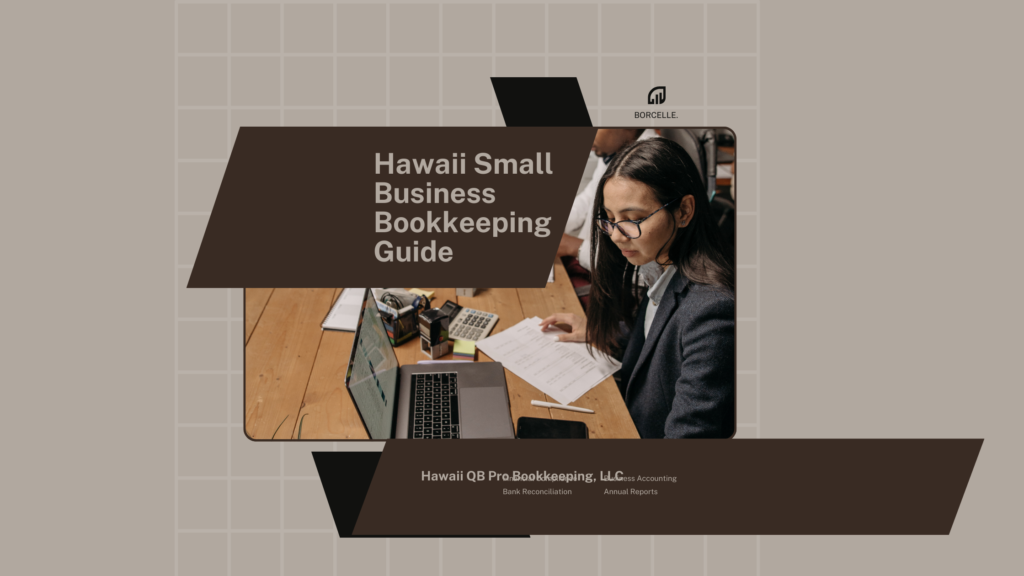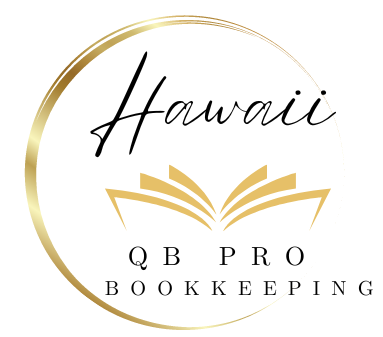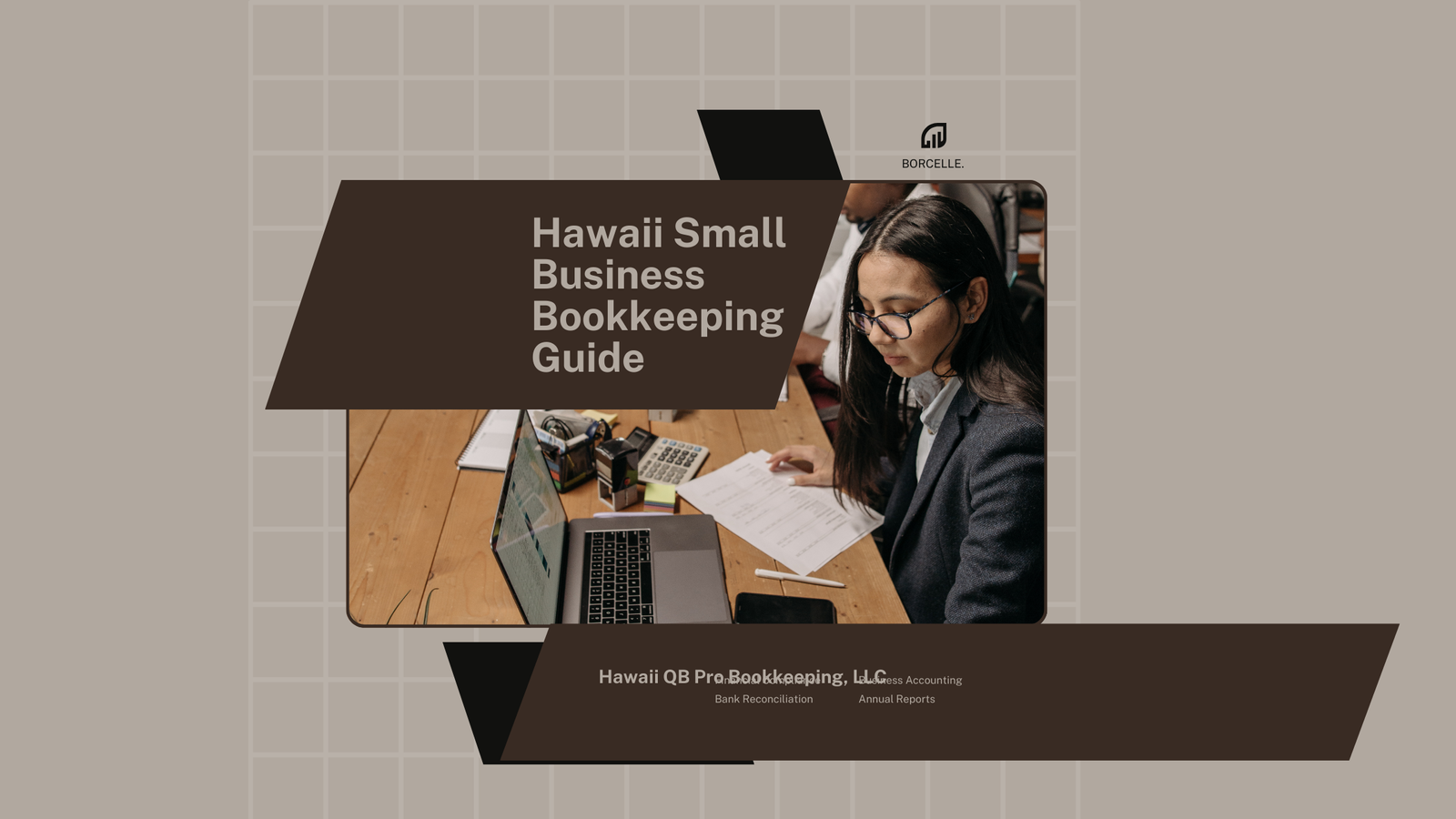Hawaii Small Business Guide to bookkeeping
Bookkeeping isn’t just a back-office chore—it’s the heartbeat of your small business—it’s essential.
Bookkeeping tracks every dollar coming in and going out, helping you understand your financial health at any moment. Whether you run a food truck in Maui, a surf shop in Oahu, or a digital consultancy from your Big Island home, having clean books keeps you compliant with Hawaii’s tax laws and enables smarter business decisions.

Bookkeeping guide for Hawaii Small Businesses
- What is the General Excise Tax (GET) in Hawaii?
- Do I need a bookkeeper or can I do it myself?
- How often should I reconcile my books?
- What bookkeeping software works best in Hawaii?
- Are there any Hawaii-specific deductions I should know about?
Hawaii Small Business Guide to Bookkeeping
Introduction to Bookkeeping for Hawaiian Entrepreneurs
Bookkeeping isn’t just a back-office chore—it’s the heartbeat of your small business, especially in Hawaii’s unique economic environment. As a business owner in the Aloha State, managing your books properly means the difference between surviving and thriving. And let’s be real, in a place where the cost of doing business can be higher than the mainland, precision with your finances isn’t optional—it’s essential.
Bookkeeping tracks every dollar coming in and going out, helping you understand your financial health at any moment. Whether you run a food truck in Maui, a surf shop in Oahu, or a digital consultancy from your Big Island home, having clean books keeps you compliant with Hawaii’s tax laws and enables smarter business decisions.
Now, why is this even more critical in Hawaii? Unlike most other states, Hawaii imposes a General Excise Tax (GET) instead of a traditional sales tax. That alone makes your bookkeeping process more complex. Plus, if you’re dealing with tourism-driven seasons, managing variable income and expenses is key to staying afloat during slow months. Good bookkeeping acts like your financial surfboard—keeping you balanced no matter how big the waves get.
Why Bookkeeping is Crucial for Small Businesses
Let’s break it down: why should you care about bookkeeping if your business is still small? Because if you don’t track your finances now, scaling will be a nightmare later. Bookkeeping helps you:
- Know your profits (or losses) at any time.
- Identify which products or services are bringing in the most cash.
- Prepare accurate tax filings.
- Avoid fines, audits, and unnecessary stress.
- Build financial statements that are essential for loans and investments.
In Hawaii, where every penny counts due to higher living and business costs, being on top of your finances gives you the clarity to price correctly, budget smarter, and ultimately grow sustainably. It’s not about being a math whiz—it’s about being in control.
Think of it like growing a garden. Without tracking which plants are thriving, how much water they need, or when you last fertilized, how do you expect to get a healthy crop? Bookkeeping gives you that insight into your financial ecosystem.
Unique Financial Landscape of Hawaii
Operating in Hawaii presents specific challenges—and opportunities—that mainland businesses might not face. For starters, everything from rent to raw materials typically costs more. Transportation logistics can also eat into your margins, especially if you rely on imported goods.
Add to that a heavily tourism-based economy that ebbs and flows with seasons and global trends. One month could be booming; the next could be slow. Your bookkeeping system needs to reflect that rhythm. Accurate financial records help you create a buffer during good months to survive the lean ones.
Then there’s the General Excise Tax (GET), which applies to nearly every transaction—yes, even services. Unlike sales tax, GET is imposed on the business, not the customer (though you can pass it on). This means your books need to reflect gross income and GET separately, so you’re not hit with surprise liabilities.
Plus, Hawaii has a small business-friendly culture with various state-supported resources. Accurate books make you eligible for grants, low-interest loans, and local development programs. If you want access to that funding, your financial paperwork has to be pristine.
Setting Up Your Bookkeeping System
Before diving into recording every dollar, you need to decide how you’ll track your financial data. There are generally two routes: manual bookkeeping (using spreadsheets or physical ledgers) or digital bookkeeping software. Both have their pros and cons, but in Hawaii—where you’re often on the go or managing multiple revenue streams—automation is your best friend.
Digital bookkeeping saves time, minimizes human error, and makes your data easily accessible—especially helpful if you’re jumping between islands or working from remote areas with limited access to physical files.
First, establish a dedicated business bank account. Mixing personal and business finances is a rookie mistake that’ll haunt you during tax season. From there, outline a chart of accounts that categorizes every type of income and expense (like rent, utilities, payroll, product costs, etc.).
Make sure to set a regular schedule for entering and reconciling transactions. A weekly routine works for most businesses, but if you’re dealing with high transaction volume (think retail or food service), daily updates might be better. Set alerts, block out time, and treat it like any other critical task.
Choosing Between Manual and Digital Bookkeeping
Manual bookkeeping might seem like a low-cost solution at first glance, but let’s be real—it’s labor-intensive and prone to error. If you’re still using Excel or even physical ledgers, one misplaced decimal or forgotten receipt could throw off your entire financial picture. And in Hawaii, where specific tax codes like GET complicate things, that’s a risk you don’t want to take.
Digital bookkeeping, on the other hand, is about working smarter. Cloud-based platforms can auto-import bank transactions, categorize expenses, and even send reminders when payments are due. Plus, with Hawaii’s mobile business culture (hello, beachside coffee shops and mobile food vendors), having your financial data accessible on-the-go is a game-changer.
The best part? These platforms often sync with payroll services, tax software, and invoicing tools, creating a seamless system that’s not only more accurate but also more efficient. The time saved alone justifies the investment.
Best Bookkeeping Software for Hawaii-Based Businesses
Finding the right bookkeeping software can feel like dating—you want something reliable, easy to get along with, and that won’t ghost you when you need support. For Hawaii-based businesses, you also need tools that can handle the state’s unique tax setup (shout out to the General Excise Tax). Let’s talk about some top contenders:
- QuickBooks Online – This is the most popular choice for small businesses, and for good reason. It’s user-friendly, cloud-based, and supports everything from invoicing and payroll to GET tracking. You can customize your sales tax settings to match Hawaii’s tax codes, making it a solid option for staying compliant.
- Xero – This cloud accounting software is a favorite among startups and freelancers. Its clean interface and strong integration capabilities make it ideal for businesses that want scalability. It’s also mobile-friendly, which is a big plus for Hawaii’s on-the-go business owners.
- Wave – If you’re just starting out and looking for a free option, Wave is a decent choice. While it lacks some advanced features like full-service payroll in Hawaii, it covers the basics well and offers strong invoicing and income/expense tracking features.
- Zoho Books – Zoho is increasingly popular among small businesses for its affordability and suite of integrated apps. It handles GET smoothly and is perfect for businesses that want an all-in-one platform.
- Local Options – Don’t overlook Hawaii-based financial service providers that offer custom solutions tailored to the state’s tax and business laws. Some CPAs and bookkeeping firms also offer their own tools or templates specifically for GET management.
No matter which software you choose, look for features like:
- Custom tax tracking
- Mobile access
- Bank and credit card integration
- Payroll compatibility
- Real-time reporting and analytics
A little research goes a long way. Try free trials to see what works best for your style of business.
Understanding Hawaii’s Tax Requirements
Taxes in Hawaii aren’t exactly straightforward. While most other states charge a sales tax paid by the consumer, Hawaii charges a General Excise Tax (GET) that the business is responsible for paying. This means your books must account for it on every sale—even if you’re a freelancer or providing services.
The GET is typically 4% on gross income, but depending on your county, a 0.5% surcharge might apply (Oahu, for example, totals 4.5%). What makes it trickier is that GET applies not just to retail goods, but also services, rent, commissions, and even bartered transactions. This means if you’re a yoga instructor in Maui or a wedding planner in Kauai, you’re on the hook.
To stay compliant, your bookkeeping should include:
- Separate tracking of GET collected vs. your actual revenue
- Invoices clearly showing GET added (if you choose to pass it on to customers)
- Records of GET-exempt sales (like wholesale transactions)
Hawaii also requires monthly, quarterly, or semi-annual GET filings, depending on your income level. Missing these can result in penalties, interest, and audits. Don’t wing it—stay consistent, automate where possible, and keep backups of all tax-related documents.
General Excise Tax (GET) Explained
Let’s dig deeper into this uniquely Hawaiian tax. The General Excise Tax (GET) is one of the biggest bookkeeping considerations for businesses in Hawaii. Unlike a traditional sales tax, which is a pass-through collected from customers, GET is a tax on your gross income—that’s everything you earn before expenses.
Here’s the breakdown:
- Retail Sales: 4% + county surcharge (if applicable)
- Wholesale: 0.5%
- Service Providers: 4% + surcharge
- Contractors: 4% (special rules apply for subcontractors)
Yes, this means if you earn $10,000 from service work on Oahu, you owe $450 in GET (4.5%) even before paying any business expenses. That’s why it’s crucial to factor GET into your pricing strategy. Many businesses choose to “pass it on” to customers by adding GET on invoices. You’re not required to—but if you don’t, you’re still paying it out of your revenue.
Your bookkeeping system should be set up to:
- Record gross income and GET separately
- Automatically calculate GET owed
- Generate reports for filing
The Hawaii Department of Taxation provides GET forms and filing systems online, but if you’re unsure, consider working with a local CPA familiar with Hawaii tax law.
Filing and Payment Deadlines in Hawaii
Timing is everything in taxes. Hawaii’s Department of Taxation sets your GET filing frequency based on your income:
- Monthly: If you earn more than $4,000/month
- Quarterly: If you earn less than $4,000/month but more than $2,000/month
- Semi-Annually: If you earn under $2,000/month
These aren’t just suggestions—they’re legally binding. Missing a deadline can result in penalties up to 25% of the tax due, plus interest. Here’s a cheat sheet to keep you on track:
- Monthly Filers: Due by the 20th of the following month
- Quarterly Filers: Due April 20, July 20, October 20, and January 20
- Semi-Annual Filers: Due July 20 and January 20
Don’t wait until the last minute. Your bookkeeping software should allow you to set calendar reminders and automate filings. If you’re doing it manually, mark those dates in bold on your planner—and consider submitting a few days early to avoid server issues or banking delays.
Common Tax Deductions for Small Businesses in Hawaii
Bookkeeping isn’t just about knowing what you owe—it’s also about knowing what you can deduct. And if you’re not tracking your deductions properly, you’re leaving money on the table. Here are some common write-offs that Hawaii small business owners often overlook:
- Home Office Expenses – If you work from home, you may qualify for a deduction based on the square footage of your home office.
- Travel Between Islands – Business trips between islands count as deductible travel expenses, including flights, meals, and lodging.
- Office Supplies and Equipment – Pens, paper, laptops, software—all of it adds up and should be logged as deductions.
- Vehicle Use – If you use your car for business, you can deduct mileage or actual expenses like gas and repairs.
- Professional Services – Fees paid to accountants, consultants, or legal advisors are fully deductible.
- GET Paid – You can deduct the General Excise Tax paid as a business expense on your federal taxes.
Always keep receipts, categorize transactions correctly, and consider tagging each expense with a note in your software. Better records = fewer headaches when tax time rolls around.
Key Bookkeeping Practices for Success
Great bookkeeping is less about fancy software and more about consistency and strategy. In Hawaii, where your business might be balancing high overhead and seasonal cash flow, having a solid routine can make or break your bottom line. Let’s break down the best practices that every Hawaii-based small business should follow:
- Separate Personal and Business Finances
This is rule #1. Always use a dedicated business bank account and credit card. Mixing personal and business expenses complicates taxes and puts you at risk during audits. - Record Transactions Promptly
Don’t wait until the end of the month to input expenses. Logging purchases and income daily or weekly helps you stay accurate and spot issues before they grow. - Set a Routine
Schedule time weekly to:
- Review income and expenses
- Reconcile bank accounts
- File receipts
- Track GET owed
- Review income and expenses
- At the end of each month, close out your books and review financial reports.
- Use Financial Reports
Get familiar with your profit and loss (P&L) statement, balance sheet, and cash flow statement. These aren’t just for accountants—they help you make smart decisions. - Backup Your Data
Whether it’s cloud-based software or manual files, back up everything. In Hawaii, natural disasters like hurricanes can hit unexpectedly. Having digital backups in the cloud could save your business. - Reconcile Regularly
Always match your books with your bank statements. Reconciling monthly (at a minimum) helps catch errors, missed deposits, or unauthorized charges.
When your bookkeeping is on point, everything else becomes easier—taxes, budgeting, planning, and even sleep.
How to Track Income and Expenses Accurately
Let’s face it: cash slips, online transfers, Venmo payments, and credit card swipes happen all over the place. Without a clear system, tracking business finances can quickly turn into chaos. But when you’re operating in Hawaii’s often multi-revenue environment—say, a tourism business with walk-ins, online bookings, and vendor contracts—precision is crucial.
Here’s how to master accurate tracking:
- Use Bank Feeds
Connect your business accounts to your bookkeeping software so transactions flow in automatically. This reduces manual entry errors. - Categorize Immediately
Don’t leave transactions “uncategorized.” Know what counts as:
- COGS (Cost of Goods Sold)
- Operational expenses
- Marketing costs
- Taxes and payroll
- COGS (Cost of Goods Sold)
- Consistent categorization makes reports meaningful.
- Digital Receipts
Go paperless. Use apps like Expensify or Shoeboxed to scan and store receipts in the cloud. Tag them by category or project. - Invoice Everything
Even for informal or recurring work, always generate invoices. It creates a paper trail and clarifies income sources for GET purposes. - Use Tags or Classes
If you operate in multiple locations or sell different product lines (say, kayak tours vs. surf lessons), use class tracking to differentiate income and expenses. - Check for Duplicates or Missing Transactions
Regularly audit your records to make sure nothing’s missing. Pay special attention to cash payments, which are easy to forget but still taxable.
Tracking accurately is like keeping a detailed travel journal. You’ll know where you’ve been, what it cost, and what paths are worth revisiting.
Organizing Receipts and Invoices
Receipts may seem like clutter, but they’re the lifeblood of clean books. Whether you’re prepping for a tax audit or just trying to remember why you spent $97 at the hardware store last month, having your paperwork in order saves time and stress.
In Hawaii, especially when dealing with the GET and potential state audits, having proper documentation can be the difference between a smooth process and a tax nightmare.
Tips for Receipt Organization:
- Go Digital: Take photos of paper receipts using apps like Hubdoc or QuickBooks mobile. Tag them by date and category.
- Use Cloud Storage: Google Drive or Dropbox can be your best friends. Create folders for each month or expense type.
- Label Everything: Include the vendor name, date, purpose, and amount.
- Match Receipts to Transactions: Use your bookkeeping software to attach receipts to the corresponding entries.
Organizing Invoices:
- Always number your invoices sequentially.
- Use invoice templates that include payment terms, GET details, and due dates.
- Keep track of unpaid invoices—late payments mess with your cash flow.
In short, treat every receipt like a mini financial report. Properly stored, it becomes a tool for deductions, evidence for audits, and a memory jogger when things get fuzzy.
Payroll Management in Hawaii
If you’ve hired employees (or even just one part-time helper), payroll isn’t just about writing checks—it’s a legal responsibility with state and federal rules attached. In Hawaii, the system is fairly straightforward but packed with critical compliance points.
Key Considerations:
- Employee vs. Contractor
Misclassifying workers is a big no-no. Employees get W-2s and have taxes withheld; contractors receive 1099s and handle their own taxes. Hawaii follows federal IRS guidelines, but always double-check. - Withholdings
You must withhold federal income tax, Social Security, Medicare, and Hawaii State Income Tax from employee paychecks. - Unemployment Insurance
Employers must pay into Hawaii’s Unemployment Insurance Fund. Rates vary based on industry and company history. - Prepaid Health Care Act
Hawaii is unique—it requires most employers to provide health insurance for employees working over 20 hours a week. - Temporary Disability Insurance (TDI)
Yes, this is also mandatory. You’ll need to provide partial wage replacement for employees unable to work due to illness or injury.
Tips for Managing Payroll:
- Use payroll software that supports Hawaii-specific tax filings (QuickBooks Payroll, Gusto, ADP).
- Keep meticulous employee records, including hours worked, pay stubs, and tax forms.
- File tax returns and make payments on time—late payroll taxes carry serious penalties.
Even with just one employee, handling payroll by the book protects your business and builds trust with your team.
Employee vs Contractor Classification
Think you can call someone a contractor just because they work part-time or from home? Not quite. In Hawaii, as elsewhere, misclassifying workers can lead to hefty fines, back taxes, and even lawsuits.
How to Tell the Difference:
- Control: If you control how, when, and where the work is done, they’re likely an employee.
- Tools and Equipment: Employees usually use your tools; contractors bring their own.
- Permanence: Ongoing, indefinite relationships point to employment.
- Exclusivity: Employees typically work only for you; contractors juggle multiple clients.
Why It Matters:
- Employees must get benefits like TDI and health insurance.
- Contractors do not—but you must issue a 1099 if you pay them over $600 annually.
- Misclassification = penalties + back taxes + interest.
Keep clear records, have contracts in place, and when in doubt, consult a local CPA or attorney.








